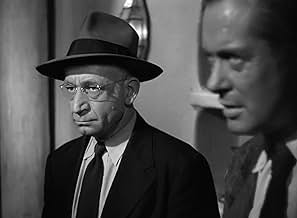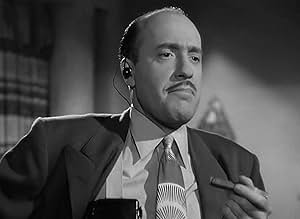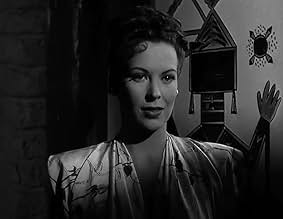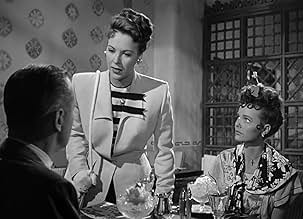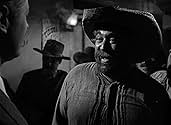NOTE IMDb
7,2/10
3,6 k
MA NOTE
Ajouter une intrigue dans votre langueWW2 veteran Lucky Gagin arrives in a New Mexico border-town intent on revenging against mobster Frank Hugo but FBI agent Bill Retz, who also wants Hugo, tries to keep Gagin out of trouble.WW2 veteran Lucky Gagin arrives in a New Mexico border-town intent on revenging against mobster Frank Hugo but FBI agent Bill Retz, who also wants Hugo, tries to keep Gagin out of trouble.WW2 veteran Lucky Gagin arrives in a New Mexico border-town intent on revenging against mobster Frank Hugo but FBI agent Bill Retz, who also wants Hugo, tries to keep Gagin out of trouble.
- Réalisation
- Scénario
- Casting principal
- Nommé pour 1 Oscar
- 1 victoire et 1 nomination au total
Avis à la une
Not quite sure what to make of this one, but definitely interesting. One is never certain if its strangeness is due to inexperience on the part of the film-makers, or if it truly is an unambiguous artistic choice. The director and star, Robert Montgomery, was very much a creature of 1930's pre-war Hollywood and the film seems to be an unconscious attempt to transplant pre-war film-making sensibilities into the decidedly post-war genre of Film-Noir, with all of its fatalism, disillusionment and complications. It's as if Montgomery is an alien from the 30's exploring a strange, post-war Noir world; rejoicing and experimenting in this permissive new environment, but ever aware that he is not a native. (Though it's highly unlikely this idea ever occurred to him in such a concrete way, as this genre was not identified as such until French critics of the 1960's uncovered a new pattern in American films dealing with crime.)
There's much here that I, quite frankly, didn't understand. You never really get a handle on any of the characters or what their true motivations are; they're all tantalizingly enigmatic, opaque, but that is admittedly much of the joy of the picture. Everyone seems to be suffering from some kind of guilt that they just don't seem quite able to articulate, much less expiate, so they keep muddling along hoping that they'll stumble across an answer or justification for their sins. The villain of the piece, Fred Clark, is odd. He doesn't just want to trick Montgomery out of the money he's blackmailing him for, he wants to shame him for not being smart and demanding more. Montgomery is mighty odd as well, with some kind of a stubborn, indecipherable personal code of honor; sort of a dumbed down Sam Spade. He's trying to carve out some little island of corruption just for himself, stiff-arming both sides of the law in the process. Most peculiar is the little peasant girl played by Wanda Hendrix. She is instantly devoted to Montgomery, lovingly helps him out of a couple jams but at the end after they say goodbye, she makes some little speech to her friends in Spanish (w.o. subtitles) that gives the impression she was never as innocent as she let on. But what did she gain? And Art Smith (a good crafty little character actor who keeps turning up and making an impression in a lot of films I've been seeing like "Brute Force", "The Next Voice You Hear" and "In A Lonely Place") is an FBI agent who is more like Montgomery's guardian angel. He is almost God-like in how he can pinpoint the exact motivation behind Montgomery's every move and thought.
All these actors are fine, but Thomas Gomez steals every scene he's in as the deceptively heroic operator of the merry-go-round. He is involved in the film's most brutal and poignant scene, as he is beat up by a couple of Clark's thugs (as the children watch captively on the spinning carousel) for refusing to reveal his friend Montgomery's whereabouts. And I love his great line when Montgomery stumbles back for help after getting stabbed in a fight. He shrugs wearily and says "when you're young everyone sticks knife in you."
I couldn't for the life of me figure out why the movie would be called "Ride the Pink Horse", but I like the other reviewer's theory that it has to do with the arbitrary nature of life itself. A definite cult item.
There's much here that I, quite frankly, didn't understand. You never really get a handle on any of the characters or what their true motivations are; they're all tantalizingly enigmatic, opaque, but that is admittedly much of the joy of the picture. Everyone seems to be suffering from some kind of guilt that they just don't seem quite able to articulate, much less expiate, so they keep muddling along hoping that they'll stumble across an answer or justification for their sins. The villain of the piece, Fred Clark, is odd. He doesn't just want to trick Montgomery out of the money he's blackmailing him for, he wants to shame him for not being smart and demanding more. Montgomery is mighty odd as well, with some kind of a stubborn, indecipherable personal code of honor; sort of a dumbed down Sam Spade. He's trying to carve out some little island of corruption just for himself, stiff-arming both sides of the law in the process. Most peculiar is the little peasant girl played by Wanda Hendrix. She is instantly devoted to Montgomery, lovingly helps him out of a couple jams but at the end after they say goodbye, she makes some little speech to her friends in Spanish (w.o. subtitles) that gives the impression she was never as innocent as she let on. But what did she gain? And Art Smith (a good crafty little character actor who keeps turning up and making an impression in a lot of films I've been seeing like "Brute Force", "The Next Voice You Hear" and "In A Lonely Place") is an FBI agent who is more like Montgomery's guardian angel. He is almost God-like in how he can pinpoint the exact motivation behind Montgomery's every move and thought.
All these actors are fine, but Thomas Gomez steals every scene he's in as the deceptively heroic operator of the merry-go-round. He is involved in the film's most brutal and poignant scene, as he is beat up by a couple of Clark's thugs (as the children watch captively on the spinning carousel) for refusing to reveal his friend Montgomery's whereabouts. And I love his great line when Montgomery stumbles back for help after getting stabbed in a fight. He shrugs wearily and says "when you're young everyone sticks knife in you."
I couldn't for the life of me figure out why the movie would be called "Ride the Pink Horse", but I like the other reviewer's theory that it has to do with the arbitrary nature of life itself. A definite cult item.
ROBERT MONTGOMERY never seemed quite as comfortable in tough guy roles as someone like Humphrey Bogart was--and this is a role that would have been ideal for Bogart. Not to say that Montgomery isn't effective--he's especially good in the latter part of the story where he must stagger around after a brutal beating. His direction too has to be commended, taut and keeping the sense of imminent danger lurking in the shadows at all times.
He plays a typical film noir character, struggling to wrong a right in a world where he feels alienated and suspicious of everyone. But it's a little too much of a one note performance with a sneer behind every sarcastic comment and never letting us know what he is really all about. That becomes true of the other characters too. We are never told why Wanda Hendrix (as a blue-eyed Mexican girl) follows him around so worshipfully after he has some rude exchanges with her. We never fully know why Pablo takes to him so instantly, enough to bear a brutal beating to keep his whereabouts a secret. Nor do we know why Art Smith follows him around at a respectful distance and seems to serve as his conscience when some expository dialogue trys to shed light on their characters. But keeping these characters as an enigma is partly what makes the film so fascinating.
Even the femme fatale is kept at a shadowy distance and Andrea King makes her an interesting woman whom we know has an ulterior motive in wanting to help Montgomery. Some extra tension is derived from the scene where Pablo (Thomas Gomez with a heavy Spanish accent) is brutally beaten while children nearby ride a carousel but become aware of their dangerous surroundings in the midst of a joyful ride.
Robert Montgomery is only partly successful as the bluntly outspoken tough guy and therein lies one of the film's chief faults. Furthermore, the low-key lighting cannot disguise the fact that almost all of the film's settings have a stagebound look to them, even the haven that Pablo supplies and where the carousel rides are taken. Most of the exteriors have that soundstage look with a rather stylized seediness to replicate a small Mexican town. It's an artificiality that cannot be ignored when watching the film.
Thomas Gomez won a Supporting Role Oscar nomination for his colorful Pablo. His thick accent reminds me of Akim Tamiroff and the other cave dwellers in Hemingway's FOR WHOM THE BELL TOLLS. Gomez gives Tamiroff a run for his money.
Summing up: a fascinating but ultimately unsatisfying film noir with an ending involving the Mexican girl that can only cause speculation. Was her true motive revealed? The answer remains obscure.
I can only repeat: what a role this would have been for Bogart!!
He plays a typical film noir character, struggling to wrong a right in a world where he feels alienated and suspicious of everyone. But it's a little too much of a one note performance with a sneer behind every sarcastic comment and never letting us know what he is really all about. That becomes true of the other characters too. We are never told why Wanda Hendrix (as a blue-eyed Mexican girl) follows him around so worshipfully after he has some rude exchanges with her. We never fully know why Pablo takes to him so instantly, enough to bear a brutal beating to keep his whereabouts a secret. Nor do we know why Art Smith follows him around at a respectful distance and seems to serve as his conscience when some expository dialogue trys to shed light on their characters. But keeping these characters as an enigma is partly what makes the film so fascinating.
Even the femme fatale is kept at a shadowy distance and Andrea King makes her an interesting woman whom we know has an ulterior motive in wanting to help Montgomery. Some extra tension is derived from the scene where Pablo (Thomas Gomez with a heavy Spanish accent) is brutally beaten while children nearby ride a carousel but become aware of their dangerous surroundings in the midst of a joyful ride.
Robert Montgomery is only partly successful as the bluntly outspoken tough guy and therein lies one of the film's chief faults. Furthermore, the low-key lighting cannot disguise the fact that almost all of the film's settings have a stagebound look to them, even the haven that Pablo supplies and where the carousel rides are taken. Most of the exteriors have that soundstage look with a rather stylized seediness to replicate a small Mexican town. It's an artificiality that cannot be ignored when watching the film.
Thomas Gomez won a Supporting Role Oscar nomination for his colorful Pablo. His thick accent reminds me of Akim Tamiroff and the other cave dwellers in Hemingway's FOR WHOM THE BELL TOLLS. Gomez gives Tamiroff a run for his money.
Summing up: a fascinating but ultimately unsatisfying film noir with an ending involving the Mexican girl that can only cause speculation. Was her true motive revealed? The answer remains obscure.
I can only repeat: what a role this would have been for Bogart!!
I don't really care very much for Robert Montgomery as a serious actor; they must have been at least a half dozen or more Hollywood actors at the time who could have handled the role better: Bogart, Cagney, Flynn, Power, Holden, Ford (etc). But despite being miscast, Montgomery pulls it off with some help from a great supporting cast. Great writing by a woman writer, Dorothy B Hughes, and a great screenplay by Lederer and Hecht (Lancaster's old buddy) provides the viewer with a real treat for atmosphere and storytelling. Gagin comes to New Mexico to square accounts with the guy who shot his partner, Shorty. Mr. Hugo is well-played by. Fred Clark. But the person who steals this film is not Montgomery, Clark or even Thomas Gomez, who was nominated for a Best Supporting Actor role as Pancho in the film. No, the film is stolen by actress, Wanda Hendrix as Pila, a wild-looking, space cadet, who is fiercely loyal to Gagin. One of the best film noir pieces you will ever see.
When a bus arrives in San Pablo, the mysterious American Lucky Gagin (Robert Montgomery) looks for the La Fonda Hotel and he meets the local Pila (Wanda Hendrix) that offers to take him there. Gagin is a tough man and army veteran and he seeks out a man called Frank Hugo (Fred Clark) and he learns that he will be back to his room only on the next day. Gagin stumbles upon FBI Agent Bill Retz (Art Smith), who is chasing the powerful mobster Frank Hugo, and he warns Gagin to forget his scheme for revenging his friend Shorty that was murdered by Frank. Then Gagin looks for a hotel room and he goes to the Bar Tres Violetas, where he befriends the owner of carousel called Pancho (Thomas Gomez) and he buys drinks for his friends in the bar. Pancho offers a place to Gagin to spend the night. On the next morning, Gagin goes to the hotel and meets Frank Hugo. He blackmails the mobster, asking for 30,000 dollars to give a check that incriminates him. Frank Hugo accepts the deal and tell that the money will be available only at 7:00 PM. Will Gagin succeed in his extortion of money from Frank?
"Ride the Pink Horse" is a different film-noir directed by Robert Montgomery, who is also the lead actor. His bitter and unpleasant character is well-developed as a war veteran disillusioned with the post-war life since his lover is unfaithful and his best friend was murdered by a mobster. Wanda Hendrix performs a weird character, maltreated by Gagin but following him like a puppy. But the plot is a good story of friendship. My vote is seven.
Title (Brazil): "Do Lodo Brotou Uma Flor" ("From the Mud Sprouted a Flower")
"Ride the Pink Horse" is a different film-noir directed by Robert Montgomery, who is also the lead actor. His bitter and unpleasant character is well-developed as a war veteran disillusioned with the post-war life since his lover is unfaithful and his best friend was murdered by a mobster. Wanda Hendrix performs a weird character, maltreated by Gagin but following him like a puppy. But the plot is a good story of friendship. My vote is seven.
Title (Brazil): "Do Lodo Brotou Uma Flor" ("From the Mud Sprouted a Flower")
From the film's opening scene, which shows the protagonist, Lucky Gagin, emerging from a bus into a dusty Mexican town, the viewer is hooked. There are so many good things about this film, primarily the acting performances -- Robert Montgomery is a standout, as are Wanda Hendrix, Fred Clark, Thomas Gomez, and Art Smith. They each completely occupy their characters and make them come to life. Another highlight is the dialogue -- there are numerous memorable exchanges between Montgomery and Hendrix, and Clark delivers two especially well-written diatribes that serve to solidify his character in the consciousness. The story itself is quite simple, and is driven far more by characterization than by plot, but that is what makes the film so good. The film also contains its share of classically dark noir imagery -- most memorable is the scene in which the Gomez character is savagely beaten by two hoods while a group of neighborhood children sail along on the nearby merry-go-round, at first gaily enjoying the free ride but growing increasingly somber and afraid as they witness the brutal attack. This one is a definite must-see, particularly for film noir buffs, but also for film lovers of all types.
Le saviez-vous
- AnecdotesFilmed in Santa Fe, the burning of Zozobra, which began in 1924, is still an annual festival occurring in September.
- GaffesOpening scene at the bus station, Montgomery walks over to the gum machine to insert his coin, but the gum package is already present before he inserts it.
- Crédits fousThe main title card reads, "as LUCKY GAGIN in RIDE THE PINK HORSE." The film's title is in far smaller type than the character name.
- ConnexionsFeatured in Pulp Cinema (2001)
Meilleurs choix
Connectez-vous pour évaluer et suivre la liste de favoris afin de recevoir des recommandations personnalisées
- How long is Ride the Pink Horse?Alimenté par Alexa
Détails
- Date de sortie
- Pays d’origine
- Langues
- Aussi connu sous le nom de
- Ride the Pink Horse
- Lieux de tournage
- Société de production
- Voir plus de crédits d'entreprise sur IMDbPro
Box-office
- Montant brut aux États-Unis et au Canada
- 2 000 000 $US
- Durée1 heure 41 minutes
- Couleur
- Rapport de forme
- 1.37 : 1
Contribuer à cette page
Suggérer une modification ou ajouter du contenu manquant

Lacune principale
By what name was Et tournent les chevaux de bois (1947) officially released in India in English?
Répondre
